Properly aligning your eyepiece mount starts with securing your alignment eyepiece firmly in the telescope port. Adjust your mount’s altitude to match your local latitude, then center Polaris in the finderscope before making fine adjustments. Balance your telescope across all axes by adjusting the counterweight system, and regularly check for drift during observations. Don’t forget to account for environmental factors like wind and temperature changes that can affect stability. These foundational steps will transform your astrophotography results.
11 Second-Level Headings for “Aligning Your Eyepiece Mount: Photography Setup Tips”
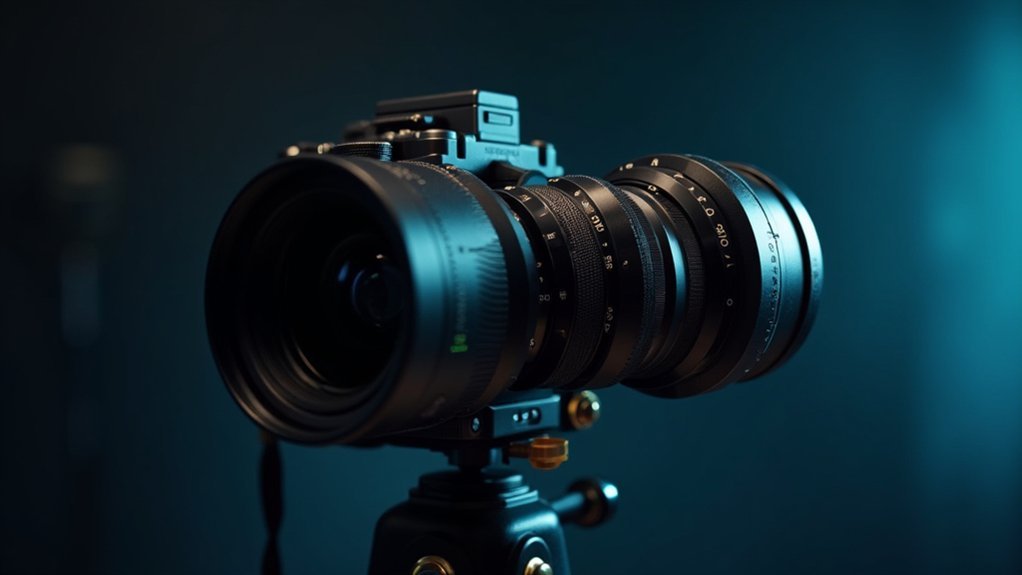
While setting up your astrophotography equipment, properly aligning your eyepiece mount serves as the foundation for successful imaging sessions. Breaking down this critical process into clear steps guarantees you’ll achieve ideal results with minimal frustration.
Consider these essential section headings for your alignment procedure:
- Selecting and Securing Your Alignment Eyepiece
- Enhancing Crosshair Visibility with Illuminator Adjustments
- Preventing Star Drift through Precise Alignment
- Creating a Stable Foundation for Telescope Setup
- Mastering One-Handed Eyepiece Installation Techniques
Each component of the alignment process builds upon the previous step, forming a thorough approach to astrophotography preparation.
When you follow these structured guidelines, you’ll greatly reduce tracking errors and improve image quality.
Remember that even minor alignment issues can profoundly impact your final results, especially during longer exposure sessions.
Understanding Equatorial Mount Mechanics
Your equatorial mount’s effectiveness depends entirely on proper polar axis alignment, where you’ll position one axis parallel to Earth’s rotation axis.
You’ll need to adjust the mount until Polaris appears centered in your finder-scope, making fine-tuning adjustments with the altitude and azimuth screws.
The right ascension (RA) axis, once properly aligned, allows you to track celestial objects by compensating for Earth’s rotation with a single continuous motion.
Polar Axis Alignment
When pursuing astrophotography, proper polar alignment stands as the foundation for capturing crisp, detailed images of celestial objects.
You’ll need to align your mount’s polar axis precisely with the north celestial pole (Polaris) if you’re observing from the northern hemisphere.
Set your mount’s altitude to match your local latitude, which you can quickly find through online resources.
If your equipment includes a polar scope, use it to enhance alignment accuracy by centering Polaris in both the finder scope and your telescope eyepiece.
Perfect polar alignment prevents star trailing during long exposures—a critical factor for successful astrophotography.
The more you practice this essential skill, the more consistent your results will become, dramatically improving your celestial images and overall observing experience.
Right Ascension Mechanics
To master astrophotography, understanding right ascension (RA) mechanics forms an essential component of equatorial mount operation.
You’ll need to guarantee the RA axis aligns parallel to Earth’s rotational axis, allowing your telescope to track celestial objects accurately as they move across the night sky.
Your mount’s RA setting circle helps you locate specific objects by their east-west coordinates, similar to longitude on Earth.
As you observe, you’ll adjust the RA axis to compensate for Earth’s rotation, following stars in their apparent east-to-west motion.
Remember that when your target crosses the meridian (reaches its highest point), you’ll need to perform a meridian flip, rotating the RA axis 180° to continue effective tracking.
This maneuver keeps your equipment properly positioned throughout your imaging session.
Essential Equipment for Proper Alignment
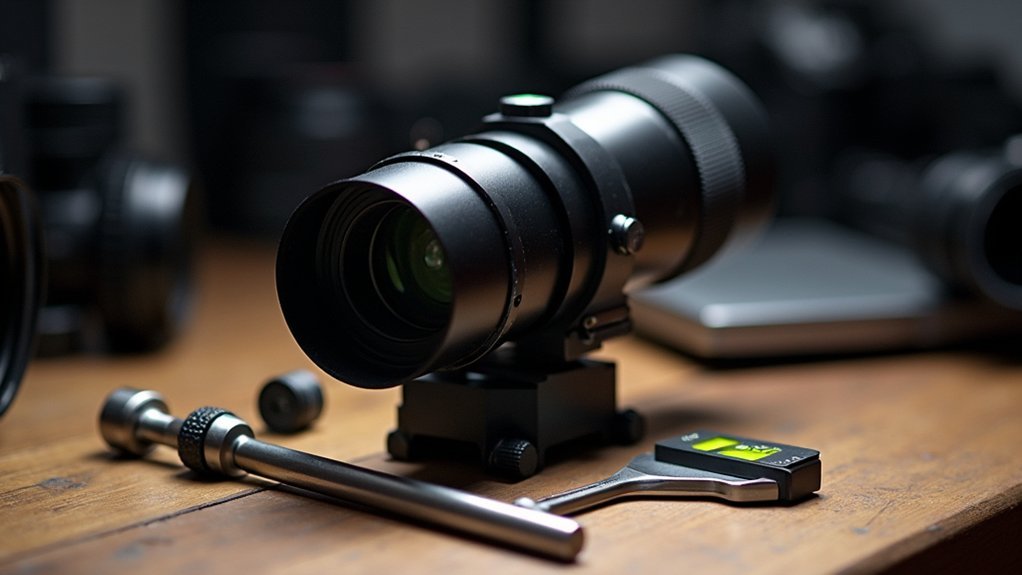
Achieving stellar results in astrophotography begins with precise alignment, which requires specific tools designed for accuracy. Your primary instrument should be a high-quality alignment eyepiece, preferably with a 20mm focal length and crosshairs.
Adding an illuminator enhances crosshair visibility during low-light sessions, dramatically improving your centering precision.
Always secure your alignment eyepiece firmly in the telescope’s eyepiece port to maintain stability throughout the alignment process. This prevents unwanted movement that could compromise your results.
Proper eyepiece security is critical—any movement will corrupt your carefully orchestrated alignment and ruin hours of work.
You’ll need regular practice with this setup to master polar alignment techniques, as even minor misalignments cause significant star drift over time.
Take time to thoroughly read your telescope’s manual for specific guidance on eyepiece usage. This familiarity will substantially improve your observation quality and streamline your astrophotography workflow.
Step-by-Step Polar Alignment Process
With your alignment tools properly set up, you’re ready to tackle the polar alignment process itself.
Proper polar alignment guarantees your mount tracks accurately across the night sky, essential for crisp astrophotography results.
Follow these steps to achieve precise alignment:
- Adjust your mount’s altitude setting to match your location’s latitude – this creates the proper starting angle for alignment.
- Center Polaris in your finderscope first, then make fine adjustments while looking through your telescope eyepiece.
- Utilize a polar finder app like PolarScope Align for enhanced precision in positioning your mount’s polar axis.
- Verify your alignment by confirming the polar axis points directly at Polaris, making minor corrections as needed.
Regular practice will improve your polar alignment skills, reducing star drift in your images.
Balancing Your Telescope for Optimal Performance
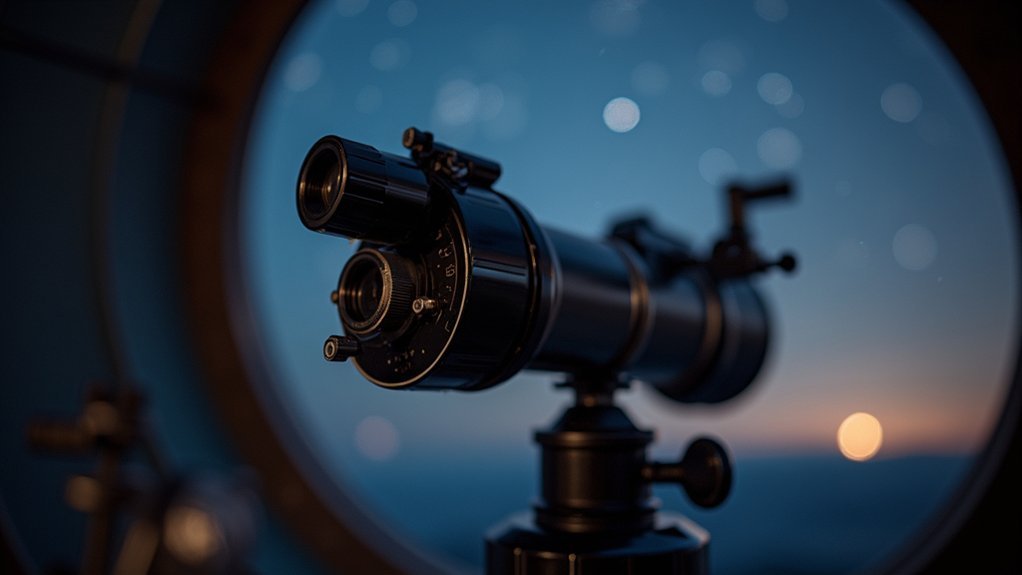
Your telescope’s tracking precision depends on proper three-axis balancing across radial, RA, and DEC planes to counteract uneven weight distribution.
You’ll need to adjust your counterweight system methodically, ensuring equal resistance when manually moving the scope in any direction.
Securing all clamping bolts and keeping tripod legs short will greatly improve your mount’s stability against wind, especially during long-exposure imaging sessions.
Three-Axis Balancing Principles
Perfect balance across all three axes stands as the foundation for successful astrophotography sessions. Achieving three-way balance requires attention to the radial, right ascension (RA), and declination (DEC) axes of your telescope.
When properly balanced, your mount will track smoothly, allowing for crisp, star-trail-free images even during longer exposures.
- Radial Balance – Particularly essential for larger scopes susceptible to wind influences
- RA Balance – Adjust counterweights until the telescope remains stationary when the clutch is released
- DEC Balance – Verify equipment distribution evenly balances across the declination axis
- Maintenance Checks – Rebalance whenever changing equipment configurations or adding accessories
Remember to verify your balance before each imaging session, as even small adjustments to your setup can greatly impact tracking performance.
Counterweight System Setup
The counterweight system represents the heart of your telescope’s balance mechanism, directly impacting the quality of your astrophotography results.
Start by firmly attaching the counterweight bar to your mount head, then slide the weights into position to counterbalance your telescope tube effectively.
You’ll need to achieve balance in all three essential directions: radial, right ascension (RA), and declination (Dec.). Adjust the counterweights along the bar until your telescope remains stationary when you release the clutches—this indicates proper balance has been achieved.
After adjustments, double-check that all clamping bolts are secure on both axes. A perfectly balanced setup not only enhances tracking accuracy but also minimizes unwanted movement from environmental factors like wind during those vital long exposures.
Wind Resistance Techniques
When gusty conditions threaten your imaging session, proper telescope balance becomes even more critical for capturing sharp astrophotographs.
Achieving stability in windy environments requires careful attention to your mount’s equilibrium across all axes.
To maximize your setup’s wind resistance:
- Establish three-way balance – Confirm radial, right ascension, and declination axis balance to minimize tracking errors and maintain stability.
- Shorten tripod legs – Keep them as compact as possible to reduce vibration and increase structural rigidity.
- Add weight to your mount – Additional mass improves resistance against gusts and external forces.
- Implement guiding techniques – Use autoguiding to correct for any remaining mechanical tracking errors when shooting long exposures.
These adjustments will greatly enhance your imaging results, especially when using larger telescopes in challenging conditions.
Eliminating Drift: Fine-Tuning Your Mount
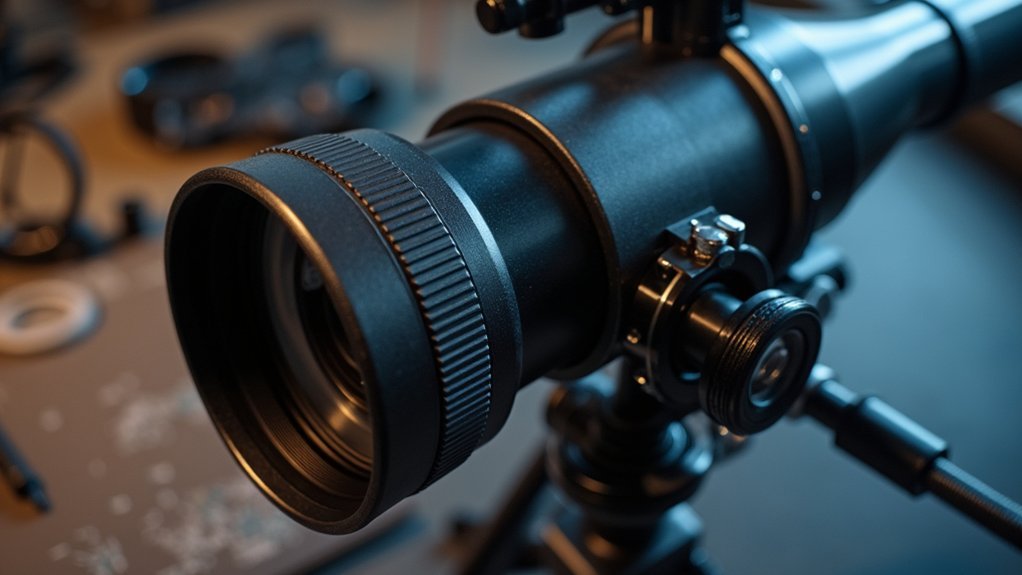
Precise tracking becomes the cornerstone of successful astrophotography once you’ve positioned your equipment and selected your target.
Even minor polar misalignments will produce frustrating star trails during long exposures, ruining your carefully planned shots.
A few arc-minutes of polar misalignment can transform potential masterpieces into disappointing star streaks.
Achieve accurate alignment using a polar finder scope or smartphone apps like Synscaninit to locate the north celestial pole properly. Your mount’s RA axis must be perfectly oriented to minimize drift.
Don’t overlook the importance of balance—check both RA and DEC axes regularly, as imbalance amplifies tracking errors.
For ideal results, implement guiding techniques with a dedicated guide scope and camera to compensate for inevitable mechanical imperfections.
Finally, verify your mount is set to sidereal tracking speed (approximately 0.75X) to match celestial objects’ movement across the night sky.
Calibrating Your Guide System
You’ll need to master the drift method basics to identify precise tracking errors in your mount’s movement.
Set up PHD Guiding by selecting a suitable guide star and allowing the software to calibrate your system’s response to directional commands.
When errors occur, you can implement correction techniques such as adjusting aggressiveness settings or implementing dithering between exposures to eliminate recurring pattern noise.
Drift Method Basics
Although many astrophotographers rely on computerized mounts, mastering the drift alignment method provides a reliable way to fine-tune your polar alignment for long-exposure photography. This technique involves tracking a star’s movement to detect and correct alignment errors in both right ascension and declination axes.
To perform a basic drift alignment:
- Select a star near the celestial equator and center it in your eyepiece while tracking in sidereal mode.
- Observe the star’s drift pattern for 10-15 minutes – vertical movement indicates altitude issues, horizontal drift signals azimuth problems.
- Make small adjustments to your mount based on the observed drift direction.
- Test your alignment with a different star to verify corrections in both axes.
Using a guide scope or camera with live view can greatly improve your ability to detect subtle drift movements.
PHD Guiding Setup
With manual drift alignment techniques in your toolkit, you can now enhance your tracking precision through automated guiding.
Unlike an altazimuth mount, your equatorial mount requires proper balance in both RA and DEC axes before connecting your guide camera.
Launch PHD2 or similar software and initiate the calibration process. Set your calibration step size between 200-800 pixels, adjusting based on your focal length.
Watch carefully as the software moves your mount east-west and north-south to analyze its response characteristics.
A successful calibration will show smooth movement with minimal backlash.
Once complete, examine the guiding graph for any periodic error patterns and fine-tune your aggressiveness settings accordingly.
These adjustments will guarantee peak tracking throughout your imaging session, delivering sharper stars and more detailed astrophotographs.
Error Correction Techniques
Once calibration completes, your guiding system needs fine-tuning to effectively eliminate tracking errors.
Mastering error correction techniques is your guide to the best astrophotography results. Review these essential adjustments to optimize your system’s performance:
- Adjust backlash settings in both RA and DEC axes of your mount to minimize tracking errors that cause unwanted star trails.
- Implement automatic correction software that processes real-time data from your guide camera, making micro-adjustments during lengthy exposures.
- Analyze guide star movement periodically through your software’s graphing tools to identify recurring patterns requiring correction.
- Check physical alignment between your guide scope and main telescope regularly, as even slight discrepancies can compound into significant tracking issues during long imaging sessions.
Weather Considerations for Alignment Accuracy
When you’re setting up for astrophotography, weather conditions can make or break your imaging session. Wind and atmospheric turbulence directly impact your eyepiece alignment precision, potentially ruining hours of careful setup.
High humidity and cloud cover will obstruct visibility, making polar alignment nearly impossible.
You’ll also need to account for nighttime temperature drops, which cause thermal contraction in your equipment. Always allow your telescope to acclimate to ambient temperature before attempting alignment.
For ideal results, seek stable atmospheric conditions—clear, calm nights with minimal turbulence provide the best environment for accurate star alignment and tracking.
Before heading out, check weather forecasts specifically for wind speeds and cloud cover. Planning your sessions around favorable weather conditions will greatly improve your alignment accuracy and ultimately produce sharper, more detailed astrophotographs.
Troubleshooting Common Alignment Issues
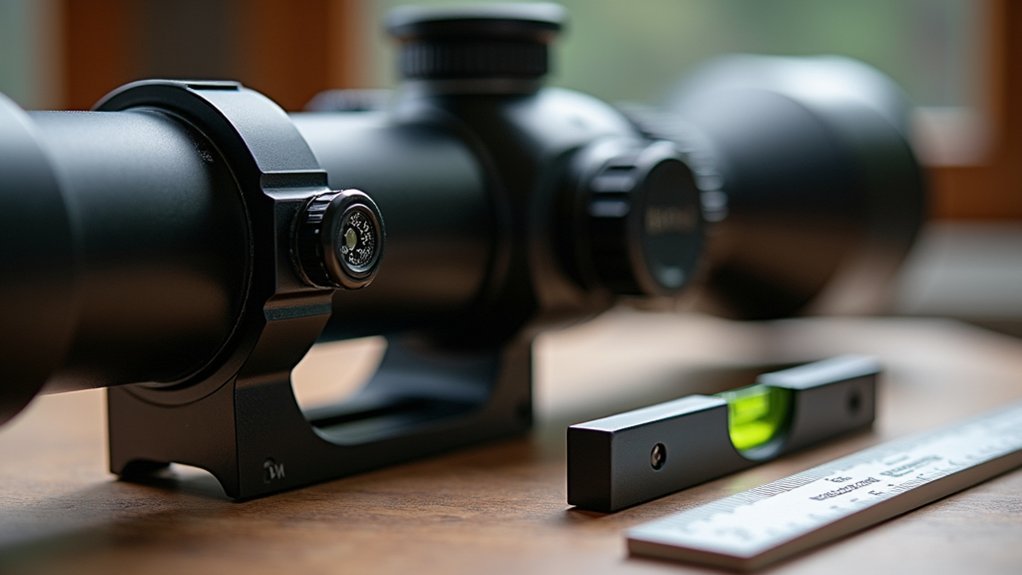
Despite your best preparation, alignment issues can frustrate even experienced astrophotographers. When problems arise, a systematic approach will help you quickly get back to capturing the night sky.
Patience and methodical troubleshooting are your best tools when alignment challenges threaten your imaging session.
- Check eyepiece security – Confirm your eyepiece is firmly seated in the port, as loose connections cause misalignment during observation or photography.
- Verify crosshair positioning – Use the illuminated crosshairs to recenter your alignment stars if you notice drift occurring.
- Adjust illuminator brightness – Fine-tune the illuminator to optimize crosshair visibility against the night sky background.
- Perform stability checks – Regularly observe known stars to verify your alignment remains accurate, especially on windy nights.
Remember that proper alignment techniques vary by mount type.
Taking time to master your specific equipment’s alignment requirements will dramatically improve your astrophotography results and prevent disappointing star trails.
Advanced Alignment Techniques for Astrophotography
After mastering basic alignment, you’ll need to develop more sophisticated techniques to capture those breathtaking deep-sky images.
Start by using a dedicated alignment eyepiece with crosshairs for precise star centering during polar alignment. Even minor misalignments will cause noticeable star drift in your photos.
Implement the drift alignment method to fine-tune your setup by monitoring star movement in both right ascension and declination axes. This allows you to make critical adjustments that improve tracking accuracy during long exposures.
Don’t overlook proper calibration of your RA and Dec scales to match specific celestial coordinates.
Consider adding a guiding system to correct for mechanical tracking errors and backlash that can ruin your images.
Regular practice of these techniques guarantees consistent, high-quality astrophotography results with your equipment.
Maintaining Your Mount’s Alignment Precision
Once you’ve achieved proper alignment, maintaining that precision becomes essential for successful imaging sessions.
Your properly polar aligned mount requires regular attention to deliver the sharp, detailed images you’re after. Throughout your observation session, environmental factors and equipment stress can gradually degrade alignment quality.
To maintain ideal alignment precision:
- Check and tighten all clamping bolts on both RA and Dec axes every 30-45 minutes
- Monitor your latitude setting against your geographical location, making micro-adjustments if star drift appears
- Utilize the RA and Dec setting circles when recentering objects to maintain your initial alignment reference
- Periodically verify alignment through your polar scope or alignment eyepiece, especially after equipment adjustments
These maintenance steps prevent frustrating drift issues during long exposures and guarantee consistent tracking accuracy throughout your imaging session.
Frequently Asked Questions
How to Align Eq Mount?
To align an EQ mount, level your tripod, point it north, set your latitude angle, balance both axes, and use a polar scope to center Polaris. Make fine adjustments to guarantee accurate tracking for astrophotography.
How Do You Align a Finderscope With an Eyepiece?
To align your finderscope with an eyepiece, center a bright star in your eyepiece first, then adjust the finderscope’s alignment screws until the same star is centered there. Verify with a star 30° away.
How Close Does Polar Alignment Need to Be?
For astrophotography, you’ll need polar alignment within a few arcminutes of the celestial pole. You can get away with less precision for visual observing, but accurate alignment enables longer exposures without star trails.
What Is a Reticle Eyepiece?
A reticle eyepiece is a telescope accessory with crosshairs or a grid etched on the lens. You’ll use it for precise alignment of celestial objects, especially during polar alignment for astrophotography to minimize star trails.
In Summary
You’ve now learned the essentials of aligning your eyepiece mount. With practice, you’ll quickly master these techniques and improve your astrophotography results. Remember to check your alignment regularly, especially after moving your equipment. Don’t get discouraged by initial challenges—even experienced astronomers make adjustments. Your patience will pay off with stunning celestial images that showcase your growing skills.





Leave a Reply